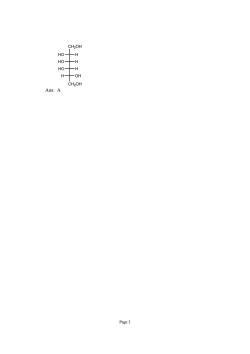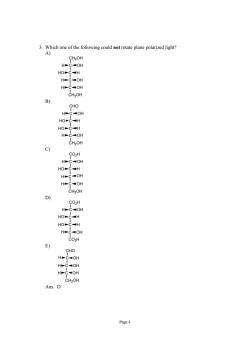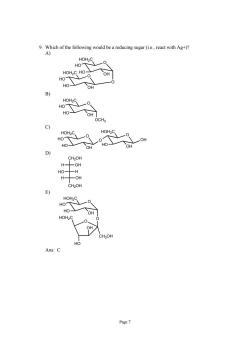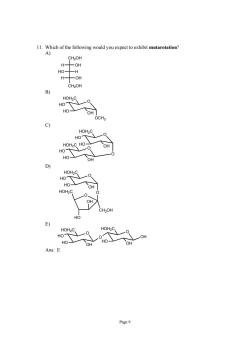北京化工大学:《有机化学》课程教学资源(章节测验,含答案)Chapter 24 Carbohydrates:Polyfunctional Compounds in Nature

What would be the name of the following sugar CH2OH H A)B-D-glucopyranose D)B-D-galactopyranose B)a-D-galactopyranose E)B-D-glucofuranose C)a-D-glucopyranose Ans:C
Page 1 1. What would be the name of the following sugar? O OH OH OH HO CH2OH A) β-D-glucopyranose D) β-D-galactopyranose B) α-D-galactopyranose E) β-D-glucofuranose C) α-D-glucopyranose Ans: C

2.Which compound would result from the following reaction? CHO HO- HO- -H Br2.H2O H0- pH5-6 H -OH CH2OH HO- H HO- HO- CH2OH hO- HO- -H H COH HO- HO- -H H0- D) E) Page2
Page 2 2. Which compound would result from the following reaction? CHO CH2OH HO H HO H HO H H OH Br2, H2O pH 5-6 ? A) CO2H CH2OH HO H HO H HO H H OH B) CHO CO2H HO H HO H HO H H OH C) CO2H CO2H HO H HO H HO H H OH D) CH2OH CH2OH O HO H HO H H OH E)

Ans:A Page3
Page 3 CH2OH CH2OH HO H HO H HO H H OH Ans: A

3.Which one of the following could not rotate plane polarized light? A) - HO T0 CH-OH Ans. Page 4
Page 4 3. Which one of the following could not rotate plane polarized light? A) CH2OH C C C C CH2OH OH H OH OH H HO H H B) CHO C C C C CH2OH OH H H H OH HO HO H C) CO2H C C C C CH2OH OH H OH H OH H HO H D) CO2H C C C C CO2H OH H H HO HO H OH H E) CHO C C C CH2OH OH OH H OH H H Ans: D

seawater Bromine i gbtheoxidaionofb Addition to n fatt tyrosine,a phenol) 9 Oxidation of aldoses to aldonic acids(e.g,CHO to CO2H) a-bromination of fatty acids(e.g.,RCH2CO2H-?RCHBrCO2H) E) None of these reactions could occur in living systems Ans:D Wfthe reactions nstw would be catalyzed 5 a glycosidase enzyme? 6-phosphate ruto6-phosphate sucrose invert sugar C) cellulose glucose 9 amylose glucose E)glucose 6-phosphate- glucose phosphate ion Ans:B 6.What would be the name of the following sugar structure? ho HO OH OH a-D-galactopyranose D)a-D-glucopyranose B-D-glucopyranose E)B-D-galactofuranose C) B-D-galactopyranose Ans:B 7.What would be the name of the following sugar? CHO H HO- -H HO CH2OH D-glucose B)L-glucose C)L-galactose D)L-mannose E) Ans: Page 5
Page 5 4. Bromine is a dense, deep red-brown liquid obtained by the oxidation of bromide ion in seawater. Bromine is very toxic. Which of the following reactions of bromine with organic materials would be least likely in a biological system (would not occur)? A) Addition to non-aromatic carbon-carbon double bonds (e.g., in fatty acids) B) Electrophillic aromatic substitution of very activated aromatic rings (e.g., in tyrosine, a phenol) C) Oxidation of aldoses to aldonic acids (e.g., CHO to CO2H) D) α-bromination of fatty acids (e.g., RCH2CO2H →?RCHBrCO2H) E) None of these reactions could occur in living systems Ans: D 5. Which of the reactions listed below would be catalyzed by a glycosidase enzyme? A) glucose 6-phosphate fructose 6-phosphate B) sucrose invert sugar C) cellulose glucose D) amylose glucose E) glucose 6-phosphate glucose + phosphate ion Ans: B 6. What would be the name of the following sugar structure? O OH OH HO HO HOH2C A) α-D-galactopyranose D) α-D-glucopyranose B) β-D-glucopyranose E) β-D-galactofuranose C) β-D-galactopyranose Ans: B 7. What would be the name of the following sugar? CHO HO H H OH HO H HO H CH2OH A) D-glucose B) L-glucose C) L-galactose D) L-mannose E) D-mannose Ans: B

8.What would result from the following series of reactions? CHO 1.HCN H -OH 2.H2,Pd, CH-OH H,O.H HO HO- -OH 3) CH2OH OH HO- -H H -OH CH-OH c) CHO H HO- H -OH CH-OH D CH2OH HO. -H H-OH CH2OH E)both A and C Ans:E Page6
Page 6 8. What would result from the following series of reactions? CHO HO H H OH CH2OH ? 1. HCN 2. H2, Pd, H2O, H+ A) HO H H OH CH2OH H OH CHO B) HO H H OH CH2OH H OH CH2OH C) HO H H OH CH2OH HO H CHO D) CH2OH HO H H OH CH2OH E) both A and C Ans: E

Which of th olowng would be a reducing suga(react with Ag HO HO HO- OH HO个 D) CH2OH H- -OH HO H H -O HO HO- OH HOH.C OH Ans:C Page7
Page 7 9. Which of the following would be a reducing sugar (i.e., react with Ag+)? A) O O OH HO HO HOH2C O OH HO HO HOH2C B) O OCH3 OH HO HO HOH2C C) O OH HO HO HOH2C O OH OH HO O HOH2C D) HO H H OH CH2OH H OH CH2OH E) O O OH HO HO HOH2C O CH2OH HOH2C HO OH Ans: C

10.Qualitatively (not quantitatively).what products would be formed from the following reaction? CHO H -OH HO-H HIO H -OH (excess) H- -OH CH2OH 品 H-C-OH D)both Band C E)A,Band C Ans:D Page8
Page 8 10. Qualitatively (not quantitatively), what products would be formed from the following reaction? CHO H OH HO H H OH H OH CH2OH ? (excess) HIO4 A) CO2 B) CH2O C) H C O OH D) both B and C E) A, B and C Ans: D

3) OH Page9
Page 9 11. Which of the following would you expect to exhibit mutarotation? A) HO H H OH CH2OH H OH CH2OH B) O OCH3 OH HO HO HOH2C C) O O OH HO HO HOH2C O OH HO HO HOH2C D) O O OH HO HO HOH2C O CH2OH HOH2C HO OH E) O OH HO HO HOH2C O OH OH HO O HOH2C Ans: E

Page 10
Page 10 12. In which of the following is a typical (most common) disaccharide linkage present (i.e., in what way does nature link most di- and poly-saccharides: 1,1' vs 1,2' vs 1,3' vs 1,4' vs 1,6')? A) O OH HO O O HOH2C OH HO HO HOH2C OH B) O O OH HO HO HOH2C O OH HO HO HOH2C C) O O OH HOH2C O OH HO HO HOH2C OH HO D) O HO O HOH2C O OH HO HO HOH2C OH HO E) O OH HO H2C O OH HO HO HOH2C OH HO O Ans: A
按次数下载不扣除下载券;
注册用户24小时内重复下载只扣除一次;
顺序:VIP每日次数-->可用次数-->下载券;
- 北京化工大学:《有机化学》课程教学资源(章节测验,含答案)Chapter 23 Ester Enolates and the Claisen Condensation:Synthesis of b-Dicarbonyl Compounds; Acyl Anion Equivalents.pdf
- 北京化工大学:《有机化学》课程教学资源(章节测验,含答案)Chapter 22 Chemistry of Benzene Substituents:Alkylbenzenes, Phenols, and Benzenamines.pdf
- 北京化工大学:《有机化学》课程教学资源(章节测验,含答案)Chapter 21 Amines and Their Derivatives:Functional Groups Containing Nitrogen.pdf
- 北京化工大学:《有机化学》课程教学资源(章节测验,含答案)Chapter 20 Carboxylic Acid Derivatives.pdf
- 北京化工大学:《有机化学》课程教学资源(章节测验,含答案)Chapter 19 Carboxylic Acids.pdf
- 北京化工大学:《有机化学》课程教学资源(章节测验,含答案)Chapter 18 Enols, Enolates, and the Aldol Condensation:a, b-Unsaturated Aldehydes and Ketones.pdf
- 北京化工大学:《有机化学》课程教学资源(章节测验,含答案)Chapter 17 Aldehydes and Ketones:The Carbonyl Group.pdf
- 北京化工大学:《有机化学》课程教学资源(章节测验,含答案)Chapter 16 Electrophilic Attack on Derivatives of Benzene:Substituents Control Regioselectivity.pdf
- 北京化工大学:《有机化学》课程教学资源(章节测验,含答案)Chapter 15 Benzene and Aromaticity:Electrophilic Aromatic Substitution.pdf
- 北京化工大学:《有机化学》课程教学资源(章节测验,含答案)Chapter 14 Delocalized Pi Systems:Investigation by Ultraviolet and Visible Spectroscopy.pdf
- 北京化工大学:《有机化学》课程教学资源(章节测验,含答案)Chapter 13 Alkynes:The Carbon–Carbon Triple Bond.pdf
- 北京化工大学:《有机化学》课程教学资源(章节测验,含答案)Chapter 12 Reactions of Alkenes.pdf
- 北京化工大学:《有机化学》课程教学资源(章节测验,含答案)Chapter 11 Alkenes; Infrared Spectroscopy and Mass Spectrometry.pdf
- 北京化工大学:《有机化学》课程教学资源(章节测验,含答案)Chapter 10 Using Nuclear Magnetic Resonance Spectroscopy to Deduce Structure.pdf
- 北京化工大学:《有机化学》课程教学资源(章节测验,含答案)Chapter 09 Further Reactions of Alcohols and the Chemistry of Ethers.pdf
- 北京化工大学:《有机化学》课程教学资源(章节测验,含答案)Chapter 08 Hydroxy Functional Group:Alcohols:Properties, Preparation, and Strategy of Synthesis.pdf
- 北京化工大学:《有机化学》课程教学资源(章节测验,含答案)Chapter 07 Further Reactions of Haloalkanes:Unimolecular Substitution and Pathways of Elimination.pdf
- 北京化工大学:《有机化学》课程教学资源(章节测验,含答案)Chapter 06 Properties and Reactions of Haloalkanes - Bimolecular Nucleophilic Substitution.pdf
- 北京化工大学:《有机化学》课程教学资源(章节测验,含答案)Chapter 05 Stereoisomers.pdf
- 北京化工大学:《有机化学》课程教学资源(章节测验,含答案)Chapter 04 Cycloalkanes.pdf
- 北京化工大学:《有机化学》课程教学资源(章节测验,含答案)Chapter 25 Heterocycles:Heteroatoms in Cyclic Organic Compounds.pdf
- 北京化工大学:《有机化学》课程教学资源(章节测验,含答案)Chapter 26 Amino Acids, Peptides, Proteins, and Nucleic Acids:Nitrogen-Containing Polymers in Nature.pdf
- 北京化工大学:《有机化学》课程教学资源(习题与答案)Chapter 01 Structure and Bonding in Organic Molecules.pdf
- 北京化工大学:《有机化学》课程教学资源(习题与答案)Chapter 02 Structure and Reactivity:Acids and Bases, Polar and Nonpolar Molecules.pdf
- 北京化工大学:《有机化学》课程教学资源(习题与答案)Chapter 03 Reactions of Alkanes:Bond-Dissociation Energies, Radical Halogenation, and Relative Reactivity.pdf
- 北京化工大学:《有机化学》课程教学资源(习题与答案)Chapter 04 Cycloalkanes.pdf
- 北京化工大学:《有机化学》课程教学资源(习题与答案)Chapter 05 Stereoisomers.pdf
- 北京化工大学:《有机化学》课程教学资源(习题与答案)Chapter 06 Properties and Reactions of Haloalkanes - Bimolecular Nucleophilic Substitution.pdf
- 北京化工大学:《有机化学》课程教学资源(习题与答案)Chapter 07 Further Reactions of Haloalkanes:Unimolecular Substitution and Pathways of Elimination.pdf
- 北京化工大学:《有机化学》课程教学资源(习题与答案)Chapter 08 Hydroxy Functional Group:Alcohols:Properties, Preparation, and Strategy of Synthesis.pdf
- 北京化工大学:《有机化学》课程教学资源(习题与答案)Chapter 09 Further Reactions of Alcohols and the Chemistry of Ethers.pdf
- 北京化工大学:《有机化学》课程教学资源(习题与答案)Chapter 10 Using Nuclear Magnetic Resonance Spectroscopy to Deduce Structure.pdf
- 北京化工大学:《有机化学》课程教学资源(习题与答案)Chapter 11 Alkenes; Infrared Spectroscopy and Mass Spectrometry.pdf
- 北京化工大学:《有机化学》课程教学资源(习题与答案)Chapter 12 Reactions of Alkenes.pdf
- 北京化工大学:《有机化学》课程教学资源(习题与答案)Chapter 13 Alkynes:The Carbon–Carbon Triple Bond.pdf
- 北京化工大学:《有机化学》课程教学资源(习题与答案)Chapter 14 Delocalized Pi Systems:Investigation by Ultraviolet and Visible Spectroscopy.pdf
- 北京化工大学:《有机化学》课程教学资源(习题与答案)Chapter 15 Benzene and Aromaticity:Electrophilic Aromatic Substitution.pdf
- 北京化工大学:《有机化学》课程教学资源(习题与答案)Chapter 16 Electrophilic Attack on Derivatives of Benzene:Substituents Control Regioselectivity.pdf
- 北京化工大学:《有机化学》课程教学资源(习题与答案)Chapter 17 Aldehydes and Ketones:The Carbonyl Group.pdf
- 北京化工大学:《有机化学》课程教学资源(习题与答案)Chapter 18 Enols, Enolates, and the Aldol Condensation:a, b-Unsaturated Aldehydes and Ketones.pdf
